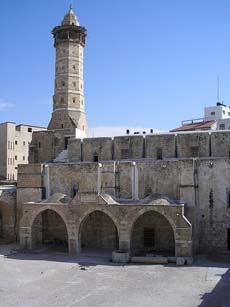Conquest of
![]() the governor of Damascus sent his brother, Mu'awiyah bin Abu Sufyaan
the governor of Damascus sent his brother, Mu'awiyah bin Abu Sufyaan ![]() towards Qaisariyah (Caesarea or Kayseri) as per the Caliph's order. After a heavy toll of 80,000 Christians, the city fell to the Muslims.
towards Qaisariyah (Caesarea or Kayseri) as per the Caliph's order. After a heavy toll of 80,000 Christians, the city fell to the Muslims.
Heraclius now ordered Artabun, a noted general, to gather troops in Ajnadain. Artabun kept a huge army under his direct command and two other detachments in Ramlah and ![]() marched to Ajnadain to face Artabun while he dispatched Alqamah bin Hakeem Firasi and Masroor bin Al-Akki to Jerusalem and Abu 'Ayyoob Al-Maliki to Ramlah with the permission of Abu 'Ubaydah
marched to Ajnadain to face Artabun while he dispatched Alqamah bin Hakeem Firasi and Masroor bin Al-Akki to Jerusalem and Abu 'Ayyoob Al-Maliki to Ramlah with the permission of Abu 'Ubaydah ![]() . A fierce battle was fought in Ajnadain. It was a conflict similar to Yarmook. Artabun could not muster courage to face 'Amr bin Al-'Aas and fled to
. A fierce battle was fought in Ajnadain. It was a conflict similar to Yarmook. Artabun could not muster courage to face 'Amr bin Al-'Aas and fled to
![]() conquered Ghazzah (Gaza), Sabastiyah, Nabulus (Nablus), Ludd, Amawas, Bayt Jibreen, and Yafa (Yafo). He then proceeded to
conquered Ghazzah (Gaza), Sabastiyah, Nabulus (Nablus), Ludd, Amawas, Bayt Jibreen, and Yafa (Yafo). He then proceeded to ![]() had proceeded to
had proceeded to ![]() was in favor of avoiding further death and destruction, so he preferred peace to war. He wrote a letter to the Caliph describing the whole account of events with the request that his arrival in
was in favor of avoiding further death and destruction, so he preferred peace to war. He wrote a letter to the Caliph describing the whole account of events with the request that his arrival in
'Umar ![]() convened a meeting of all the distinguished Companions and consulted them. 'Uthman
convened a meeting of all the distinguished Companions and consulted them. 'Uthman ![]() declared that the Christians had been struck with terror and had lost heart and that if the Caliph were to reject their request, they would be still more humiliated, and consider that the Muslims regarded them with utter contempt, they would lay down their arms unconditionally. 'Ali
declared that the Christians had been struck with terror and had lost heart and that if the Caliph were to reject their request, they would be still more humiliated, and consider that the Muslims regarded them with utter contempt, they would lay down their arms unconditionally. 'Ali ![]() however, dissented from this view and gave the contrary opinion; and 'Umar shared the same opinion.
however, dissented from this view and gave the contrary opinion; and 'Umar shared the same opinion.
On this historic mission to ![]() the Chief of the Muslims, when he left Al-Madeenah, the headquarters of Islam. Leaving 'Uthman
the Chief of the Muslims, when he left Al-Madeenah, the headquarters of Islam. Leaving 'Uthman ![]() in charge of Al-Madeenah, he set out on the journey noted for its strain and stress.
in charge of Al-Madeenah, he set out on the journey noted for its strain and stress.
It was a unique scenario of Islamic equality and human dignity, that at times, the Caliph sat on the camel and the slave walked along holding the rein of the camel and at other times, vice versa. It was the journey of a magnificent and powerful Islamic ruler whose cavalry had already trampled down palaces and crowns and thrones under the hooves of its horses. It was Rajab 16 AH (After Hijrah), when Mada'in and Antakiyah (
The commanders of the Muslim forces at ![]() received the Caliph of Islam with exemplary honor. However, when 'Umar
received the Caliph of Islam with exemplary honor. However, when 'Umar ![]() saw them arrayed in brilliant dresses and imposing appearance, he flew into a fit of rage at the sight of them and remarked: "Within the short span of two years have you fallen into Persian habits?" However, when the officers explained that they had their weapons beneath their luxurious dresses and they had not lost their Islamic character, the Caliph gained peace of heart.
saw them arrayed in brilliant dresses and imposing appearance, he flew into a fit of rage at the sight of them and remarked: "Within the short span of two years have you fallen into Persian habits?" However, when the officers explained that they had their weapons beneath their luxurious dresses and they had not lost their Islamic character, the Caliph gained peace of heart.
The Caliph stayed for a long while at Jabiah, where some of the nobles of the city proceeded to see him and the treaty was drawn up there. The elite of the Companions like Khalid bin Al-Waleed, 'Amr bin Al-'Aas, ‘Abdur-Rahman bin ‘Awf and Mu'awiyah ![]() subscribed to it.
subscribed to it.
The Conquest of
During 'Umar's stay in ![]() marched to
marched to
Afterwards the Muslim army advanced further and laid siege around 'Ayn ash-Shams and from there dispatched two squadrons to besiege Farama and ![]() to Fustat as a commander; he conquered the fortified citadel after a heavy encounter. 'Amr bin Al-'Aas attacked
to Fustat as a commander; he conquered the fortified citadel after a heavy encounter. 'Amr bin Al-'Aas attacked
The area of conquests during the Caliphate of 'Umar ![]() is said to have spread over 2,2,500,000 square miles. This was the result of victories won by people who were once considered “small and wretched” against the mighty empires of
is said to have spread over 2,2,500,000 square miles. This was the result of victories won by people who were once considered “small and wretched” against the mighty empires of ![]() himself in 22 AH, were Makkah, Al-Madeenah, Syria, Jazirah, Basrah, Kufah, Egypt, Palestine, Khurasan, Azerbaijan and Persia. Some of them were equal to two provinces in area, with two centers of power and separate governors and their administrations.
himself in 22 AH, were Makkah, Al-Madeenah, Syria, Jazirah, Basrah, Kufah, Egypt, Palestine, Khurasan, Azerbaijan and Persia. Some of them were equal to two provinces in area, with two centers of power and separate governors and their administrations.
Firsts accomplished by 'Umar
'Umar ![]() invented and enforced many things in the sphere of financial, political, administrative and social spheres, which are accomplishments first instituted by him. Some of them are mentioned below:
invented and enforced many things in the sphere of financial, political, administrative and social spheres, which are accomplishments first instituted by him. Some of them are mentioned below:
· He set up a formal Bayt-ul-Mal or public treasury and introduced the Hijri calendar
· He adopted the appellation of Ameer Al-Mu'mineen (Commander of the Faithful)
· He established a regular department for the military; a separate department for financial affairs, and fixed the salaries for men in voluntary services.
· He also introduced the practice of measuring the land and keeping its record, adopted a census system, he had canals dug and populated cities like Koofah, Basrah, Jeezah, Fustat (
· He was first to allow traders of rival countries to enter Muslim territories for the purpose of business.
· He was also the first to make use of the whip for corporal punishment and set up a prison and police department.
· He introduced a system of collecting direct information concerning states and conditions of the masses, he established a secret intelligence service.
· He had wells bored, built houses and fixed a daily payment for the destitute among the Christians and the Jews.
Martyrdom of 'Umar Al-Farooq
![]() was one day walking in Al-Madeenah when a Persian youth, named Fayrouz who was known by the patronymic `Abu-Lu'lu'ah, met him. That youth was a slave under Al-Mugheerah bin Shu'bah
was one day walking in Al-Madeenah when a Persian youth, named Fayrouz who was known by the patronymic `Abu-Lu'lu'ah, met him. That youth was a slave under Al-Mugheerah bin Shu'bah ![]() and had been taken captive after the conquest of Nahawand. He complained to the Commander of the Faithful about his master, saying that he had imposed upon him a very heavy tax. 'Umar asked him about his job, and he answered that he worked as a carpenter, a blacksmith and a house painter. Then 'Umar
and had been taken captive after the conquest of Nahawand. He complained to the Commander of the Faithful about his master, saying that he had imposed upon him a very heavy tax. 'Umar asked him about his job, and he answered that he worked as a carpenter, a blacksmith and a house painter. Then 'Umar ![]() remarked that the tax his master had imposed upon him was quite fair, but the youth was not happy with that remark, and went away full of indignation.
remarked that the tax his master had imposed upon him was quite fair, but the youth was not happy with that remark, and went away full of indignation.
The next day when the people assembled in the mosque to perform the morning prayer, Fayrouz came into the mosque armed with a poisonous dagger. As the ranks of the congregation were put straight and in order, and 'Umar ![]() came up and took his position at the head of the ranks to lead the prayer, Fayrouz suddenly rushed from the first rank and struck 'Umar six consecutive blows, one of which fell below his navel.
came up and took his position at the head of the ranks to lead the prayer, Fayrouz suddenly rushed from the first rank and struck 'Umar six consecutive blows, one of which fell below his navel.
![]() led his funeral prayer. '
led his funeral prayer. '![]() lowered his body into the grave and performed the burial service.
lowered his body into the grave and performed the burial service.


 Home
Home Discover Islam
Discover Islam Quran Recitations
Quran Recitations Lectures
Lectures
 Fatwa
Fatwa Articles
Articles Fiqh
Fiqh E-Books
E-Books Boys & Girls
Boys & Girls  Ramadan
Ramadan Fatwa Audios
Fatwa Audios Month of Mercy
Month of Mercy Women
Women Eed Al- Fitr
Eed Al- Fitr Food Recipes
Food Recipes Videos
Videos

 Prayer Times
Prayer Times












